|
What is
a Laser?
LASER is an
acronym which stands for Light Amplification by Stimulated Emission of
Radiation. The energy generated by the laser is in or near the optical
portion of the electromagnetic spectrum (see Figure 1). Energy is
amplified to extremely high intensity by an atomic process called
stimulated emission. The term "radiation" is often misinterpreted
because the term is also used to describe radioactive materials or
ionizing radiation. The use of the word in this context, however, refers
to an energy transfer. Energy moves from one location to another by
conduction, convection, and radiation. The color of laser light is
normally expressed in terms of the laser's wavelength. The most common
unit used in expressing a laser's wavelength is a nanometer (nm). There
are one billion nanometers in one meter.

The optical
spectrum. Laser light is nonionizing and ranges from the
ultra-violet (100 - 400nm), visible (400 - 700nm), and infrared (700nm -
1mm).
Laser
Hazards & Beam Hazards
The laser
produces an intense, highly directional beam of light. If directed,
reflected, or focused upon an object, laser light will be partially
absorbed, raising the temperature of the surface and/or the interior of
the object, potentially causing an alteration or deformation of the
material. These properties which have been applied to laser surgery and
materials processing can also cause tissue damage. In addition to these
obvious thermal effects upon tissue, there can also be photochemical
effects when the wavelength of the laser radiation is sufficiently
short, i.e., in the ultraviolet or blue region of the spectrum. Today,
most high-power lasers are designed to minimize access to laser
radiation during normal operation. Lower-power lasers may emit levels of
laser light that are not a hazard.
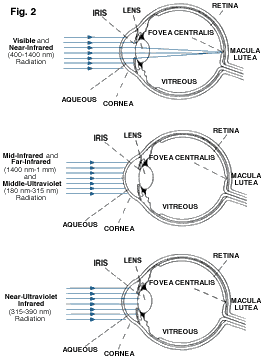
The
human body is vulnerable to the output of certain lasers, and under
certain circumstances, exposure can result in damage to the eye and
skin. Research relating to injury thresholds of the eye and skin has
been carried out in order to understand the biological hazards of laser
radiation. It is now widely accepted that the human eye is almost always
more vulnerable to injury than human skin. The cornea (the clear, outer
front surface of the eye's optics), unlike the skin, does not have an
external layer of dead cells to protect it from the environment. In the
far-ultraviolet and far-infrared regions of the optical spectrum, the
cornea absorbs the laser energy and may be damaged. Figure 2 illustrates
the absorption characteristics of the eye for different laser wavelength
regions (From Sliney & Wolbarsht, Safety with Lasers and Other Optical
Sources, Plenum Press, 1980). At certain wavelengths in the
near-ultraviolet region and in the near-infrared region, the lens of the
eye may be vulnerable to injury. Of greatest concern, however, is laser
exposure in the retinal hazard region of the optical spectrum,
approximately 400 nm (violet light) to 1400 nm (near-infrared) and
including the entire visible portion of the optical spectrum. Within
this spectral region collimated laser rays are brought to focus on a
very tiny spot on the retina. This is illustrated in Figure 3(From Sliney & Wolbarsht, Safety with Lasers and Other Optical Sources, Plenum
Press, 1980).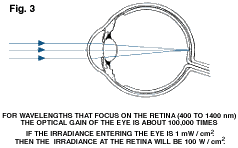
In order
for the worst case exposure to occur, an individual's eye must be
focused at a distance and a direct beam or specular (mirror-like)
reflection must enter the eye. The light entering the eye from a
collimated beam in the retinal hazard region is concentrated by a factor
of 100,000 times when it strikes the retina. Therefore, a visible, 10 milliwatt/cm2 laser beam would result in a 1000 watt/cm2 exposure to the
retina, which is more than enough power density (irradiance) to cause
damage. If the eye is not focused at a distance or if the beam is
reflected from a diffuse surface (not mirror-like), much higher levels
of laser radiation would be necessary to cause injury. Likewise, since
this ocular focusing effect does not apply to the skin, the skin is far
less vulnerable to injury from these wavelengths.
If the eye
is not focused at a distance or if the beam is reflected from a diffuse
surface (not mirror-like), much higher levels of laser radiation would
be necessary to cause injury. Likewise, since this ocular focusing
effect does not apply to the skin, the skin is far less vulnerable to
injury from these wavelengths.
Non-Beam
Hazards
In addition to the direct hazards to the eye and skin from the laser
beam itself, it is also important to address other hazards associated
with the use of lasers. These non-beam hazards, in some cases, can be
life threatening, e.g. electrocution, fire, and asphyxiation. Table 1
indicates some of the potential non-beam hazards associated with laser
usage. Because of the diversity of these hazards, the employment of
safety and/or industrial hygiene personnel to effect the hazard
evaluations may be necessary.
Safety
Standards
There are a variety of laser safety standards including Federal and
state regulations, and non-regulatory standards. The most important and
most often quoted is the American National Standards Institute's Z136
series of laser safety standards. These standards are the foundation of
laser safety programs in industry, medicine, research, and government.
The ANSI Z136 series of laser safety standards are referenced by the
Occupational Safety and Health Administration (OSHA) and many U.S.
states as the basis of evaluating laser-related occupational safety
issues.
ANSI Z136.1
Safe Use of Lasers, the parent document in the Z136 series, provides
information on how to classify lasers for safety, laser safety
calculations and measurements, laser hazard control measures, and
recommendations for Laser Safety Officers and Laser Safety Committees in
all types of laser facilities. It is designed to provide the laser user
with the information needed to properly develop a comprehensive laser
safety program.
For
manufacturers of laser products, the standard of principal importance is
the regulation of the Center for Devices and Radiological Health (CDRH),
Food and Drug Administration (FDA) which regulates product performance.
All laser products sold in the USA since August 1976 must be certified
by the manufacturer as meeting certain product performance (safety)
standards, and each laser must bear a label indicating compliance with
the standard and denoting the laser hazard classification.
Laser
Hazard Classification
Research
studies, along with an understanding of the hazards of sunlight and
conventional, man-made light sources have permitted scientists to
establish safe exposure limits for nearly all types of laser radiation.
These limits are generally referred to as Maximum Permissible Exposures
(MPE's) by laser safety professionals. In many cases it is unnecessary
to make use of MPE's directly. The experience gained in millions of
hours of laser use in the laboratory and industry has permitted the
development of a system of laser hazard categories or classifications.
The manufacturer of lasers and laser products is required to certify
that the laser is designated as one of four general classes, or risk
categories, and label it accordingly. This allows the use of
standardized safety measures to reduce or eliminate accidents depending
on the class of the laser or laser system being used. The following is a
brief description of the four primary categories of lasers:
Class 1
A Class 1
laser is considered safe based upon current medical knowledge. This
class includes all lasers or laser systems which cannot emit levels of
optical radiation above the exposure limits for the eye under any
exposure conditions inherent in the design of the laser product. There
may be a more hazardous laser embedded in the enclosure of a Class 1
product, but no harmful radiation can escape the enclosure.
Class 2
A Class 2
laser or laser system must emit a visible laser beam. Because of its
brightness, Class 2 laser light will be too dazzling to stare into for
extended periods. Momentary viewing is not considered hazardous since
the upper radiant power limit on this type of device is less than the
MPE (Maximum Permissible Exposure) for momentary exposure of 0.25 second
or less. Intentional extended viewing, however, is considered hazardous.
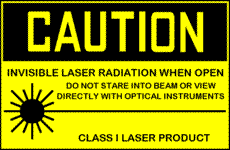
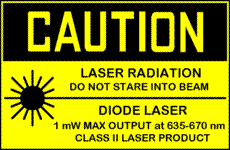
Class 3
A Class 3
laser or laser system can emit any wavelength, but it cannot produce a
diffuse (not mirror-like) reflection hazard unless focused or viewed for
extended periods at close range. It is also not considered a fire hazard
or serious skin hazard. Any continuous wave (CW) laser that is not Class
1 or Class 2 is a Class 3 device if its output power is 0.5 W or less.
Since the output beam of such a laser is definitely hazardous for
intrabeam viewing, control measures center on eliminating this
possibility.
According to the laser
power, Class 3 is divided into two groups: Class 3A and Class 3B.
Under the class 3A, the output power of
visible lasers is located in 1 - 5mW. It is generally thought that the
beam will be unsafe to human eyes. To expose eyes to the laser radiation
would result in a permanent retina damages. It is prohibited that eye or
skin exposure direct to the laser beam. Under the class 3B, the output
power is between 5 - 500mW. The ones of invisible lasers are higher than
500mW. The eye retina will be heavily injured when exposed to the laser
radiation under this class. It is prohibited that people stare into the
beam including the reflected and scattered beam from high reflecting
surfaces.
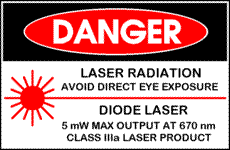
Class 4
A Class 4 laser or laser system is any that exceeds the output limits
(Accessible Emission Limits, AEL's) of a Class 3 device. As would be
expected, these lasers may be either a fire or skin hazard or a diffuse
reflection hazard. Very stringent control measures are required for a
Class 4 laser or laser system.
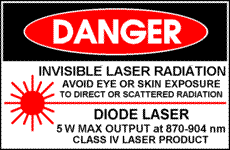
The Laser
Safety Officer
ANSI Z136.1 specifies that any facility using Class 3b or Class 4 lasers
or laser systems shall designate a Laser Safety Officer to oversee
safety for all operational, maintenance, and servicing situations.
This person
should have the authority and responsibility to monitor and enforce the
control of laser hazards. This person is also responsible for the
evaluation of laser hazards and the establishment of appropriate control
measures.
The Laser
Safety Officer (LSO) may be a full or part-time position depending on
the demands of the laser environment. This person may be someone from
occupational health and safety, industrial hygiene, or similar safety
related departments. The LSO may also be part of the engineering or
production department. In any case, the LSO must be provided the
appropriate training to properly establish and administer a laser safety
program.
Some of the
duties the LSO may perform include hazard evaluation and establishment
of hazard zones, control measures and compliance issues, approval of
Standard Operating Procedures and maintenance/service procedures,
approval of equipment and installations, safety training for laser
personnel, recommendation and approval of personal protective equipment,
and other administrative responsibilities.
Controlling Laser Hazards
Like any other potentially hazardous operation, lasers can be used
safely through the use of suitable facilities, equipment, and well
trained personnel. The ANSI Z136 series of laser safety standards
provide a detailed description of control measures which can be put into
place to protect against potential accidents.
These
control measures are divided into two distinctive categories,
Engineering Controls and Administrative/Procedural Controls. Examples of
Engineering Controls include protective housings and interlocks,
protective filter installations, key-controls, and system interlocks.
Administrative/Procedural Controls include standard operating procedures
and personal protective equipment.
Engineering
Controls are generally more costly to develop but are considered far
more reliable by removing the dependence on humans to follow rigorous
procedures and the possibility of personal protective equipment failure
or misuse.
Administrative/Procedural Controls are designed to supplement
Engineering Controls to assure that laser personnel are fully protected
from potential laser hazards. The focus of these controls are to provide
adequate education and training, provisions for protective equipment,
and procedures related to the operation, maintenance and servicing of
the laser.
Safety
training is desired for those working with Class 3 lasers and systems.
Operation within a marked, controlled area is also recommended. For
Class 4 lasers or systems, eye protectors are almost always required and
facility interlocks and further safeguards are used. Control measures
for each laser classification are defined fully in the ANSI Z136.1 laser
safety standard. This document is the single most important piece of
information regarding the safe use of lasers and should be part of every
laser safety program. For more information on laser safety, please refer
to this standard. ANSI Z136 laser safety standards may be obtained by
contacting Laser Institute of America at 407-380-1553. |
